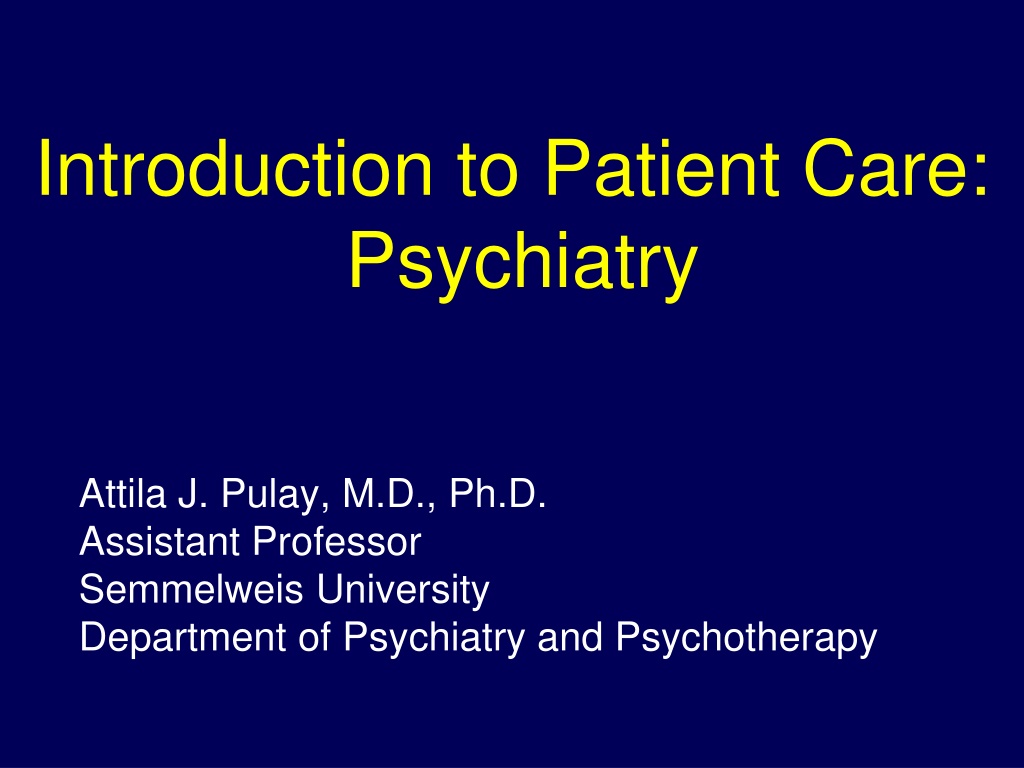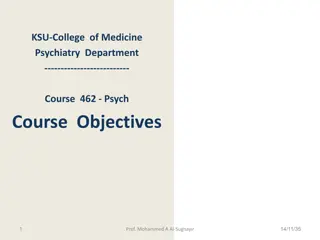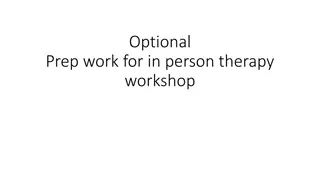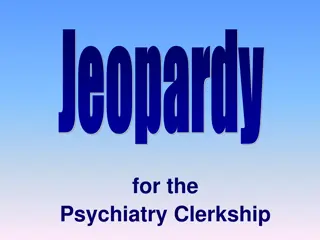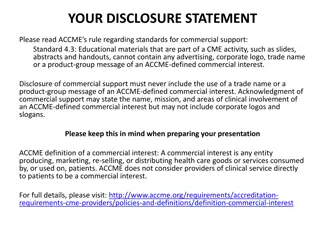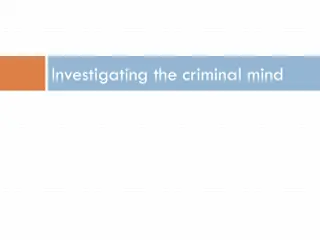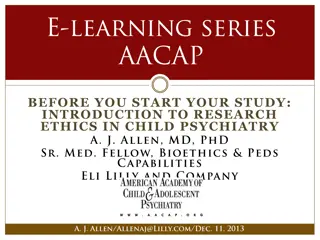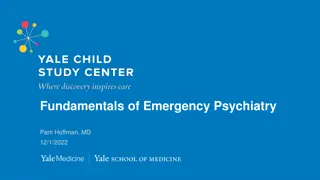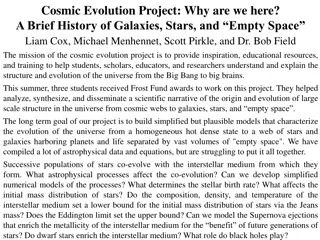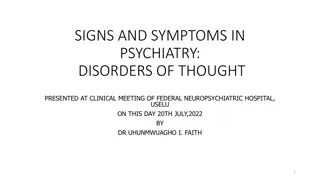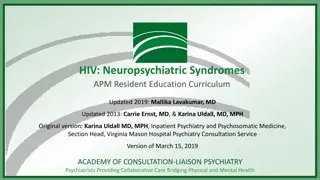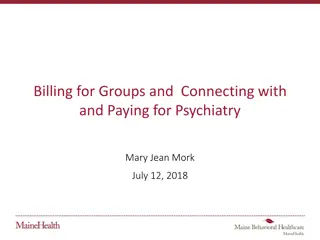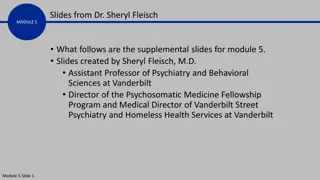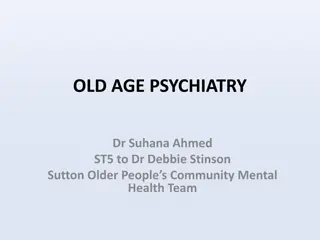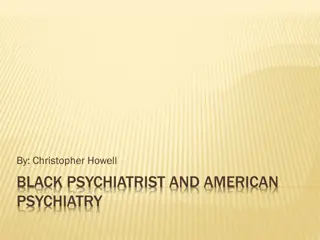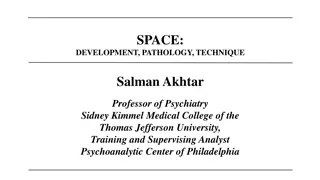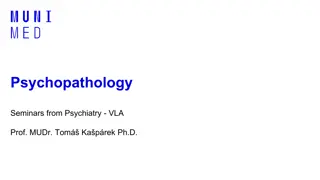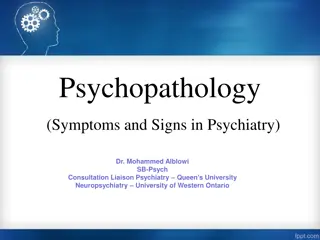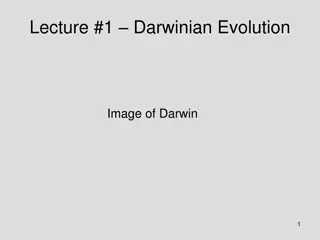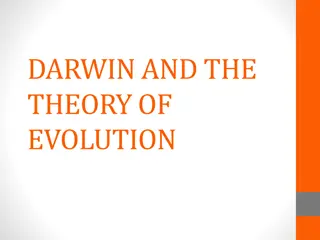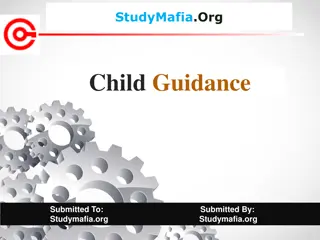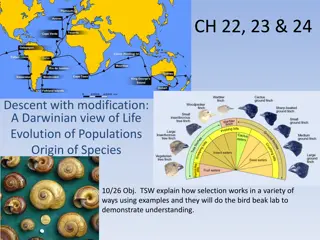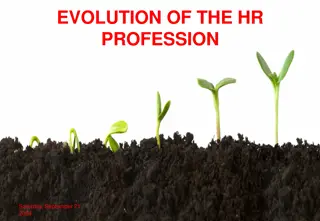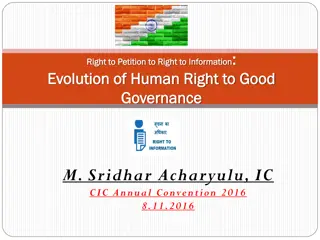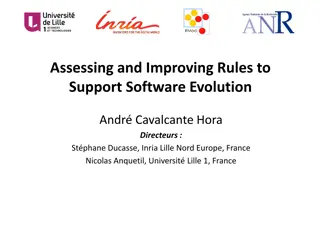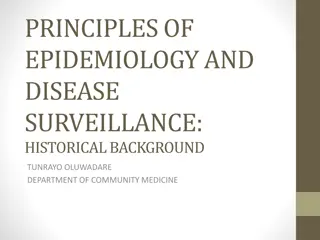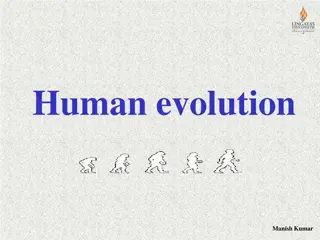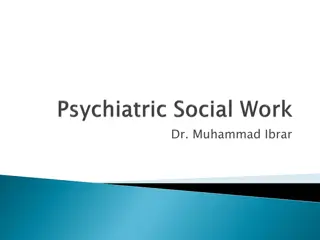Evolution of Psychiatry: A Historical Journey through Time
Psychiatry, a field blending clinical practice, biology, and social sciences, has ancient roots dating back to Graeco-Roman philosophers like Plato and Hippocrates. Significant historical milestones include the body humor hypothesis, the first mental health ward, and the emergence of psychiatric asylums in Europe. Pioneers like Al-Razi, Paracelsus, and Johann Weyer reshaped the understanding of mental illness, emphasizing biological and environmental factors. This synopsis offers a captivating narrative of the evolution of psychiatric care.
Download Presentation

Please find below an Image/Link to download the presentation.
The content on the website is provided AS IS for your information and personal use only. It may not be sold, licensed, or shared on other websites without obtaining consent from the author. Download presentation by click this link. If you encounter any issues during the download, it is possible that the publisher has removed the file from their server.
E N D
Presentation Transcript
Introduction to Patient Care: Psychiatry Attila J. Pulay, M.D., Ph.D. Assistant Professor Semmelweis University Department of Psychiatry and Psychotherapy
Psychiatry: the meeting point of clinical profession, biology, social sciences, and human care
Synopsis Historical roots Scientific background Clinical practice
The Graeco-Roman period Alcmaeon (ca. 500 B.C.): mental processes are located in the brain Plato (427?-347 B.C.): tripartie soul of thought, desire, emotion; rational part in the brain Aristotle (384-322 B.C.): the task of the brain is to cool the blood Raphael`s Plato
Hippocrates (460-377 B.C.) The body humor hypothesis: Black bile melancholia Yellow bile mania Hysteria disease of uterus Paranoia Sacred disease - epilepsy Galen (129-199 A.D.) Imagination, reason and memory Morositas deadening of the emotional life Paraphrosune paranoia Alienation bizarre behavior Rubens` Hippocrates Mural painting depicting Galen and Hippocrates (Anagni)
The first ward for the mentally ill: Hospital of Baghdad Al-Razi (865-925): scholar of Greek medicine, philosopher and alchemist Textbook of Al-Razi
Psychiatric Asylums in Europe Bethlem Hospital, London (1330) Salp tri re, Paris (1675) Asylum of Budapest (1886)
Paracelsus (1493-1541) - experimentation in learning about the human body - sickness and health in the body relied on the harmony of man, the microcosm, and Nature, the macrocosm - using this analogy not in the manner of soul-purification but that humans must have certain balances of minerals in their bodies - illnesses of the body and soul had chemical remedies that could cure them the concept of medicine
Johann Weyer(1515-1588) Psychiatric illness is not a consequence of transcendent factors - De Praestigiis Daemonum et Incantationibus ac Venificiis (On the Illusions of the Demons and on Spells and Poisons), 1563 - De Lamiis Liber (Book on Witches), 1577 - Pseudomonarchia Daemonum (The False Kingdom of the Demons), 1577
Thomas Willis(1621-1675) - Cerebri anatomi , 1664 (the term neurology ) - Pathologicae cerebri, et nervosi generis specimen , 1667 - Two Discourses concerning The Soul of Brutes, Which is that of the Vital and Sensitive of Man , 1672 (the first English work on medical psychology)
Philippe Pinel (1745-1826) Humanization of the treatment of the mentally ill
Johann Christian Reil (1759 -1813): the term Psychiatry in 1808 (psyche - soul Iatros doctor) The first psychiatric university department:1865, Berlin K roly Laufenauer, 1882, Budapest America: Benjamin Rush (1745-1813), American Psychiatric Association (1844) Emil Kraepelin (1856-1926): classification of mental disorders Eugen Bleuler: the term schizophrenia Sigmund Freud (1856-1939): psychoanalysis
Kraepelin's view Freud's view Treated patients with severe mental disorders in asylums Treated less severe outpatients Origin of illness: brain pathology Origin of illness: repressed unconscious (sexual) desires, abnormal psychosexual development
Psychiatric disorders today: The heritage Symptom Ancient XIX. century Today Acute disorder of consciousness, disorientation Phrenitis Delirium Infectious and toxic psychosis Acute organic disorders Disorders due to general medical condition Dementia Psychiatric symptoms caused by neurological disorders Lack, decline or loss of mental functions Dementia, amentia Dementia paralytica (syphylis) Degenerative psychosis of old age Low mood, loss of pleasure and motivation or the opposite Hallucinations (hearing voices), bizarre beliefs and behavior Melancholia Mania Manic-depressive psychosis Melancholia Bipolar disorder Unipolar depression Mania Dementia praecox (Bleuler s schizophrenia) Paranoia Moral insanity Schizophrenia Delusive disorder Predatoriness, lack of compassion, empathy and foresight - Antiscocial personality disorder Anxiety, phobias, body symptoms with no objective origin Hysteria Neuroses Anxiety disorders Somatoform disorders Dissociative disorders
The dark side of psychiatry Torture of patients in medieval ages Patients were closed in large institutions Political psychiatry (Soviet Union and Nazis) Lobotomy, insulin coma, electroconvulsive therapy with no anaesthesia No scientific bases of mental illness Psychoanalysis is a myth and not science 1960: antipsychiatry movement (David Cooper, Thomas Szasz)
What happens if we reject and forget psychiatry? Attempts in Italy as an influence of antipsychiatry Patients on the street and behind the bars Patients as victims and criminal offenders Restriction of psychiatry services due to financial shortcuts (USA today) US Dept. of Justice (1999): 16% of inmates in jails have severe mental illness Human Right Watch Report (2003): on a given day 70000 psychotic patients are in prisons
Response and development Social psychiatry and assertive community treatment Closing asylums and helping patients find their way back to the community using modern psychotherapy Development of neuroscience Molecular genetics, brain imaging, and pharmacology
Is it true that psychiatric disorders lack scientific bases?
basal ganglia thalamus brainstem hippocampus Limbic system amygdala
- Higher cognition (lateral part) - Emotional and social functions (bottom part) - Schizophrenia, ADHD, OCD (Pre)Frontal lobe: Basal ganglia: - Movement regulation - Skill and habit learning (feedback and reward) - Parkinson`s disease, ADHD, OCD Amygdala: - Emotion, fear, anxiety - Depression, anxiety disorders Hippocampus: - Remembering facts and events (explicit memory) - Alzheimer`s disease
Cells are abnormally localized and disorganized in the brain of schizophrenia patients
Enlarged ventricles and smaller hippocampus in schizophrenia
PET shows increased release of the neurotransmitter DOPAMINE in schizophrenia Antipsychotic drugs, such as haloperidol, block dopamine in the brain and reduce hallucinations and delusions
The genetics of the serotonin transporter affects your vulnerability to stress Serotonin transporter short (s) and long (l) versions Hariri et al., 2002; Caspi et al., 2003
The effect of antidepressants (venlafaxine) and interpersonal psychotherapy on brain activation (fMRI) Martin et al., 2001
Genes and brain networks for schizophrenia and depression: a new era in psychiatry
Clinical practice What is the definition of a psychiatric disorder? What kind of disorders do we treat? What methods do we use? How does the system work? What is the perspective for a mentally ill?
Simple questions, difficult answers Have you ever felt depressed or anxious? had problems with attention and memory? felt that strange things happen to you? believed that ghosts and aliens exist? been frightened? had sleeping problems or nightmares? had problems with alcohol or drugs?
If so, do you have a psychiatric disorder? Psychiatric disorder: severe and prolonged impairment of affect, cognition, and behavior leading to social dysfunction fulfill official diagnostic criteria DSM-5: Diagnostic and Statistical Manual of Mental Disorders, fifth revision (2013)
How to make a diagnosis in psychiatry? Examination (+ internal, neurological) Observation Heteranamnesis (informant report) Diagnostic questionnaires/interviews Rating scales Laboratory tests Imaging
Psychotic disorders Psychosis: loss of contact with reality Delusion, hallucination, strange or bizarre behavior, emotional disturbance Schizophrenia Schizoaffective disorder Paranoia Psychosis due to other mental illness Drug induced psychosis
A story of a famous mathematician, John Nash, who lives with SCHIZOPHRENIA: - Hallucinations (e.g. voices in your head giving you messages) - Delusions (e.g. false beliefs of persecution or special power)
Mood disorders Major depression (unipolar) Bipolar disorders: Depressive episodes Manic/hypomanic episodes Mixed mood episodes Persisting depressive disorder Cyclothymic disorder Premenstrual dysphoric disorder
DEPRESSION: abnormal sadness, loss of joy and motivation, decreased energy, desperation, and suicide Van Gogh Hemingway
Anxiety disorders Panic disorder Generalized anxiety disorder Phobias agoraphobia social phobia Specific phobias Obsessive-compulsive disorder PTSD
Substance use disorders Nicotine Alcohol Cannabis Amphetamine (speed, ecstasy) Designer drugs Cocaine Heroine
Cannabis and schizophrenia Gene-environment interaction Psychosis (SCH) risk for COMT Val158 carrier cannabis users Caspi, 2005
Eating disorders Anorexia Weight loss > 15% Fear of becoming fat Disturbance in body experience Bulimia Binge eating Night eating Muscle dysmorphia
Organic mental disorders Dementias Alzheimer s disease Vascular dementia More than 100 types Mental retardation Psychiatric disorders due to internal or neurological conditions
Suicide Suicide attempt Risk factors: untreated depression, psychosis, SUD, social problems 50% of schizophrenia and bipolar patients Completed suicide 2-40/100.000 people/year worldwide 10% of schizophrenia patients 20% of bipolar patients PREVENTION WITH APPROPRIATE TREATMENT!
Mental health care Outpatient care facilities Community care, private practice Hospitals Types of admission: Voluntary Involuntary (in case of dangerous behavior to others or self) Long-term programs for patients with SUD
Therapeutical approaches Pharmacotherapy Biological treatments Light therapy TMS (transcranial magnetic stimulation) ECT (electroconvulsive therapy) Psychotherapy Social therapy
Psychotherapy Interaction and communication between 2 or more persons Goal: reduction of symptoms, increasing coping skills, better insight and personality development Non-specific factors: understanding, acceptance, empathy, congruence Specific factors: gaining insight of the subconscious, modifying abnormal thinking, correcting abnormal relationships
Modern psychotherapy Instead of the interpretation of subconscious sexual fantasies and dreams: 1. Focusing on abnormal thinking (e.g. extreme pessimism and hopelessness in depression) COGNITIVE-BEHAVIOR THERAPY 2. Focusing on human relationships (e.g. dispute, role changes, grief, communication skills) INTERPERSONAL PSYCHOTERAPY
Modern social therapy Instead of large institutions to isolate ( store ) the patients: 1. Case manager that helps the patient in everyday activity 2. Sheltered houses 3. Supported employment 4. Daytime hospitals and clubs 5. Social skill training
Summary The roots of psychiatry: religion, alchemy, philosophy, psychology, and neuroscience From black bile and demons to mindreading techniques of fMRI/PET and genes From torture and misery to humanity and empathy
Thank you for your attention! Questions/Comments?
